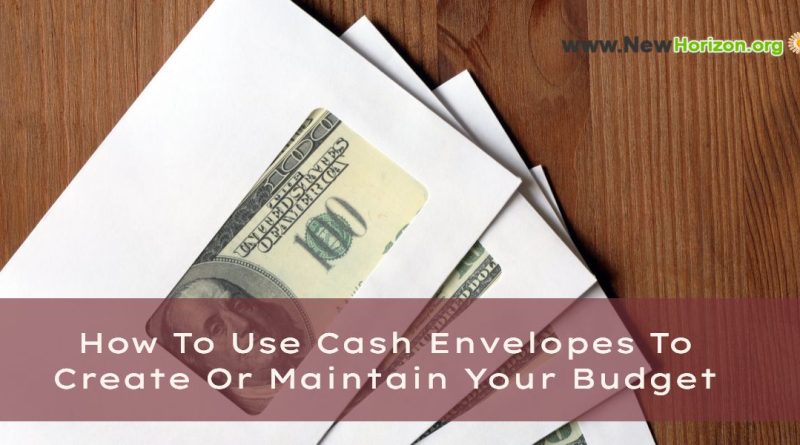How To Use Cash Envelopes To Create And Maintain Your Budget
Are you tired of overspending and struggling to stay within your budget? Look no  further than cash envelopes! This simple yet effective budgeting method has been around for years, and it’s not hard to see why. By allocating specific amounts of cash into designated envelopes for different expenses, you can easily track your spending and avoid overspending in areas where you tend to go overboard.
further than cash envelopes! This simple yet effective budgeting method has been around for years, and it’s not hard to see why. By allocating specific amounts of cash into designated envelopes for different expenses, you can easily track your spending and avoid overspending in areas where you tend to go overboard.
If you’re new to the world of cash envelopes, don’t worry – we’ve got you covered! In this article, we’ll walk you through the basics of how to use cash envelopes effectively to create or maintain your budget. Whether you’re looking to save more money or just get a better handle on your finances, this simple tool can be a game-changer.
How to use cash envelopes for budgeting:
-
-
- Determine Your Income: Calculate your total monthly income. This includes all sources of income, such as your salary, freelance work, or any other consistent payments you receive.
- Track Your Expenses: Review your past spending habits by examining your bank statements, credit card statements, and receipts. Categorize your expenses into different categories such as groceries, dining out, entertainment, transportation, utilities, debt payments, and savings. This will give you a clear understanding of where your money is going.
- Set Financial Goals: Identify your financial goals, such as saving for a vacation, paying off debt, or building an emergency fund. Determine how much money you want to allocate to each goal every month.
- Allocate Funds to Categories: Based on your income, expenses, and financial goals,
 assign a specific amount of money to each category. Start with the most essential categories like housing, utilities, and groceries. Then allocate amounts to discretionary categories like entertainment and dining out. Ensure that the total amount allocated to all categories does not exceed your income.
assign a specific amount of money to each category. Start with the most essential categories like housing, utilities, and groceries. Then allocate amounts to discretionary categories like entertainment and dining out. Ensure that the total amount allocated to all categories does not exceed your income.
Common categories include:
rent/mortgage
groceries
dining out
entertainment
transportation
utilities
debt payments
and savings.Customize the categories based on your specific needs and priorities.
- Determine Cash or Percentage Allocation: Decide whether you want to allocate a fixed amount of cash to each category or a percentage of your income. Both methods can work, so choose the one that suits your preferences and financial situation.

-
-
Setting Up Your Cash Envelopes
- Choose Your Cash Envelopes: Collect a set of envelopes or small pouches,
 one for each budget category. You can use plain envelopes, or if you prefer a more organized approach, you can purchase budgeting envelopes or create your own using cardstock or laminated paper.
one for each budget category. You can use plain envelopes, or if you prefer a more organized approach, you can purchase budgeting envelopes or create your own using cardstock or laminated paper. - Label the Envelopes: Write the name of each budget category on the front of the corresponding envelope. For example, label one envelope as “Groceries,” another as “Entertainment,” and so on. This step helps you visually identify and separate your funds.
- Allocate Cash to Envelopes: Take the budgeted amount of cash for each category and place it inside the respective envelope. For instance, if you allocated $200 for groceries, put $200 in the “Groceries” envelope. Repeat this process for each budget category.
- Use Envelopes for Spending: Whenever you need to make a purchase within a specific category, take the required amount of cash from the respective envelope. For example, when shopping for groceries, only use the cash from the “Groceries” envelope. This method helps you stay accountable and prevents overspending.
- Track Your Expenses: Keep a record of your spending for each category. You can use a simple notebook, a budgeting app, or a spreadsheet to log the date, amount spent, and category. Regularly update your spending records to stay aware of how much money is left in each envelope.
- Refill Envelopes as Needed: As you spend money from each envelope, you will eventually deplete the cash. At this point, evaluate whether you need to refill the envelope from your monthly budget or if you can adjust your spending in that category for the remainder of the month. Refill the envelopes as necessary to maintain your budget.
- Review and Adjust: Regularly review your spending habits and assess whether
 your allocated amounts are appropriate for each category. You may discover that you need to make adjustments as you become more aware of your spending patterns. Flexibility is key in maintaining an effective budget.
your allocated amounts are appropriate for each category. You may discover that you need to make adjustments as you become more aware of your spending patterns. Flexibility is key in maintaining an effective budget. - Use Cash Envelopes for Savings: You can also use cash envelopes to save money. Allocate a specific amount for savings and create an envelope dedicated to this category. Treat it like any other expense, putting the allocated cash into the envelope and avoiding using it for any other purpose.
- Choose Your Cash Envelopes: Collect a set of envelopes or small pouches,
Using cash envelopes is a simple but powerful way to create and maintain your budget. By allocating specific amounts of money to each category of spending, you can stay on track and avoid overspending. Plus, it’s a great way to stay mindful of your money and make intentional choices with your spending. As you get started with cash envelopes, be patient with yourself and allow for some trial and error as you figure out what works best for you. With time and practice, this method can help you achieve your financial goals and live the life you want. So why not give it a try? Grab some envelopes, fill them up with cash, and see how it can transform the way you manage your money.
By following these steps, you can use cash envelopes to create and maintain a budget effectively. The visual and tactile nature of this method can help you stay more connected to your spending, increase awareness, and foster better money management habits.

